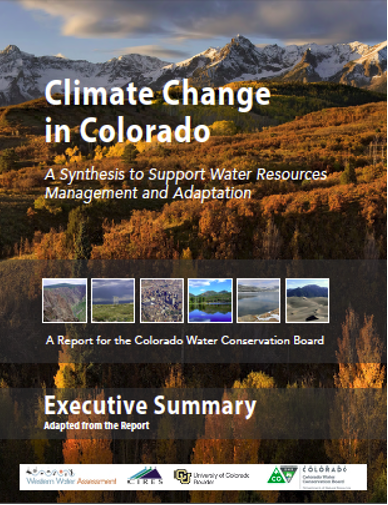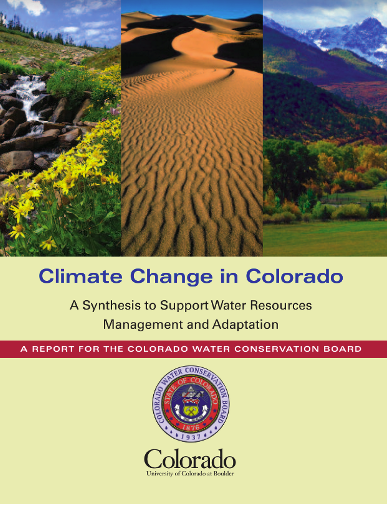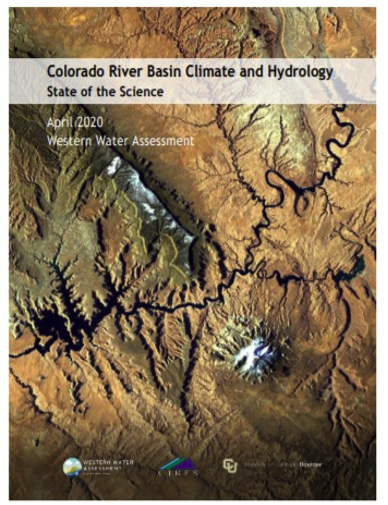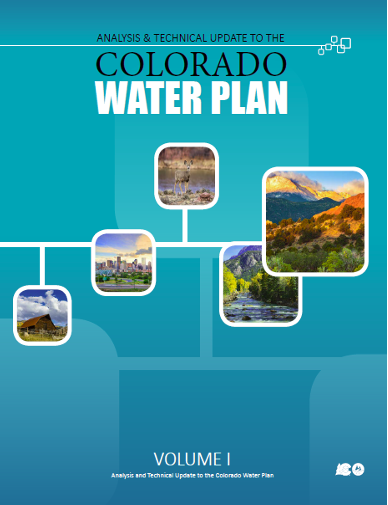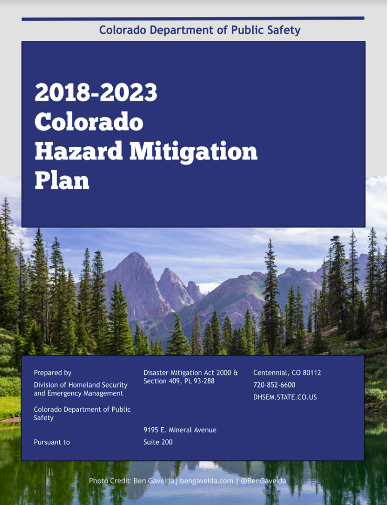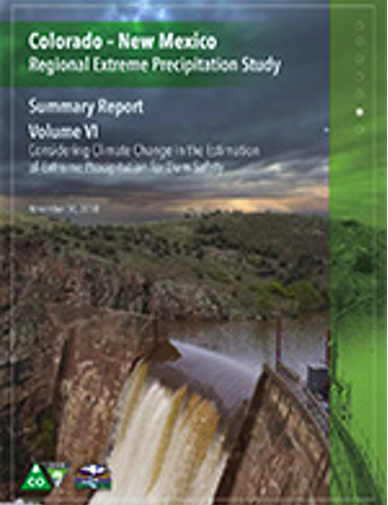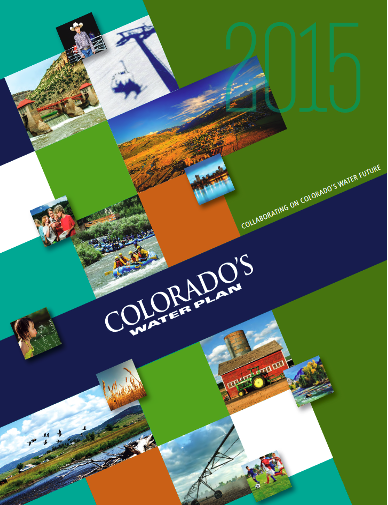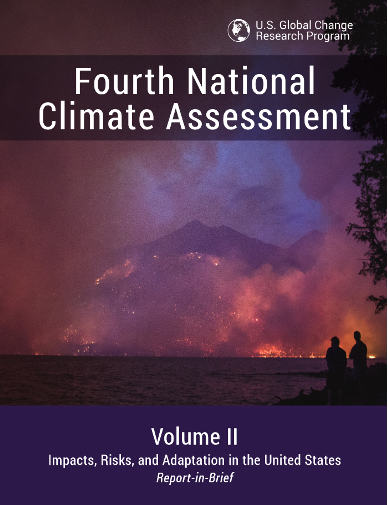Lead Agency: Colorado Water Conservation Board
Contractors/Authors: Western Water Assessment, University of Colorado; Colorado Climate Center, Colorado State University (J. Lukas, et al.)
Online:
Full report (114 pp.): https://dnrweblink.state.co.us/cwcb/0/doc/191995/
Electronic.aspx?searchid=e3c463e8-569c-4359-8ddd-ed50e755d3b7
On Western Water Assessment: https://wwa.colorado.edu/sites/default/files/
2021-07/Climate_Change_CO_Report_2014_FINAL.pdf
Type of report:
Climate assessment. Mainly synthesis of existing studies; several new analyses (historical climate, historical snowpack, projected climate and runoff)
Content relevant to Colorado climate change:
All
Type(s) of climate information:
Physical science (Ch. 1-5)
Impacts and vulnerabilities (Ch. 5-6)
Executive summary:
Pp. 1-4 of full report; available separately at:
https://wwa.colorado.edu/sites/default/files/2021-09/Exec_Summary_Climate_Change_CO_Report_2014_FINAL.pdf
Description:
The 2014 Climate Change in Colorado report closely follows the organization of the 2008 report of the same name, but with substantial expansion of topics and discussion of findings. In addition to covering observed trends in climate and hydrology, climate modeling, links between Colorado trends and global changes, and future projections of climate and hydrology, a new final chapter discusses how to use climate change information to support water planning. New sections and sidebars cover impacts such as dust-on-snow, beetle infestations, flooding, and wildfire.
Key climate-change findings:
Statewide temperatures have increased by 2 F in the past 30 years (1983-2012) and 2.5 F in 50 years (1963-2012).
All climate models indicate future warming. Statewide temperatures are projected to warm by 2.5 F to 5 F by 2050 under an emissions scenario (RCP4.5) comparable to the one in the 2008 report.
No long-term trends in annual precipitation have been detected; climate model projections of change in annual precipitation by 2050 range from -5% to +6%.
Long-term snowpack trends at the basin scale have not been consistently detected; most projections of Colorado’s spring snowpack by 2050 show declines of up to 30%.
Spring snowmelt and runoff has shifted earlier by 1-4 weeks and will shift earlier by another 1-3 weeks by 2050.
Hydrology projections indicate a tendency towards future decreases in annual streamflow for all of Colorado’s river basins.
Lead agency: Colorado Water Conservation Board
Contractors: Western Water Assessment, University of Colorado; Colorado Climate Center, Colorado State University (A. Ray, et al.)
Online:
Full report (52 pp.):
https://dnrweblink.state.co.us/CWCB/0/edoc/138509/ClimateChangeinColorado.pdf
Type of report:
Climate assessment. Mainly synthesis of existing studies; several new analyses (historical climate, projected climate)
Content relevant to Colorado climate change:
All
Type(s) of climate information:
Physical science (Ch. 1-5)
Impacts and vulnerabilities (Ch. 6)
Executive summary:
Pp. 1-2 of full report
Description:
The 2008 Climate Change in Colorado report was the first-state level assessment of climate change science for Colorado, highlighting the science most relevant to Colorado’s water resources. The report covers observed trends in climate and hydrology, climate modeling, and future projections of temperature, precipitation, snowpack, and runoff. The report summarizes Colorado-specific findings from peer-reviewed regional studies, and presents new graphics derived from existing datasets.
Key climate-change findings:
Temperatures have increased about 2 F in Colorado in the past 30 years (1977-2006).
Climate models project Colorado will warm about 4 F (2.5 F to 5.5 F) by 2050.
No long-term trends in precipitation have been detected, and climate models do not agree whether annual precipitation will increase or decrease in the future.
Snowpack changes in Colorado have been small so far; modest declines (10-20%) in high-elevation snowpack are projected by 2050.
Spring snowmelt and runoff has shifted earlier by 2 weeks and will shift even earlier in future decades.
Hydrology projections suggest declining runoff for most of Colorado’s river basins in the 21st century.
Lead Agency:Western Water Assessment
Authors/Editors: Western Water Assessment, University of Colorado; Colorado State University (Eric Gordon and Dennis Ojima)
Online:
Full report (176 pp.):
https://wwa.colorado.edu/sites/default/files/2021-08/GordonOjima2015.pdf
Type of report:
Vulnerability study submitted to the Colorado Colorado Energy Office
Content relevant to Colorado climate change:
All
Type(s) of climate information:
Physical science (Ch. 2)
Vulnerability across sectors (Ch. 4-10)
Executive summary:
Located at beginning of report
Description:
The Colorado Climate Change Vulnerability Study provides an overview of key vulnerabilities that climate variability and change will pose for Colorado’s economy and resources. The purpose of the study is to provide state agencies, local governments, and others with background for preparedness planning.
Sponsors:
Consortium of water management agencies led by Reclamation, Southern Nevada Water Authority, and Colorado Water Conservation Board, including Denver Water and the Colorado River District
Contractors: Western Water Assessment, University of Colorado, with NCAR, U. or Arizona, U. (J. Lukas and L. Payton, et al.)
Online:
Web page: https://wwa.colorado.edu/resources/colorado-river-resources/CRBreport
Full report (520 pp.): https://wwa.colorado.edu/sites/default/files/2021-06/
ColoRiver_StateOfScience_WWA_2020_FullReport_hi-res.pdf
Type of report:
Science and technical assessment.
Synthesis of existing studies.
Content relevant to Colorado climate change:
Chapter 2.10 - Recent hydroclimatic trends and likely causes
Chapter 11 - Climate change-informed hydrology
Type(s) of climate information:
Physical science (Ch. 2, 11)
Executive summary:
Pp. 1-29 of full report; available separately at: https://wwa.colorado.edu/sites/default/files/2022-01/ColoRiver_StateOfScience_WWA_2020_Executive_Summary.pdf
Description:
This report was intended to create a shared understanding of the climate and
hydrology of the Colorado River Basin (CRB) and the latest data, tools, and
research underpinning the management of Colorado River water resources. By
identifying both challenges and opportunities, the report informs efforts by
water resource managers and researchers to improve short-term and mid-term
forecasts and long-term projections for the basin's water system.
While only two chapters specifically speak to ongoing and expected climate change in the CRB, the other chapters may provide useful background on the various datasets and tools for monitoring, modeling, and forecasting climate and h ydrology (snowpack, runoff, soil moisture, evapotranspiration)--many of which are part of understanding climate change impacts.
Key climate-change findings:
Since 2000, temperatures in the CRB have been 2 F warmer than the 20th-century average, and likely warmer than at any time in the last 2000 years.
Total annual flows from the Upper Basin (Lees Ferry) have decreased since 2000, a portion of this decline is attributable to the warming.
Annual temperatures in the CRB are projected to rise by 2.5 F to 5 F by 2050 under RCP4.5.
The projected trends in annual precipitation for the CRB vary by model and are generally small compared to the natural variability in precipitation.
Nearly all studies of projected future CRB hydrology since 2006 show a strong tendency towards lower annual runoff in both the Upper and Lower basins.
Lead Agency: Colorado State Forest Service
Online:
Web page: https://csfs.colostate.edu/forest-action-plan/
Full report (85 pp.): https://csfs.colostate.edu/wp-content/uploads/
2020/10/2020-ForestActionPlan.pdf
Type of report:
Assessment and strategies for Colorado's Forest Priorities.
Content relevant to Colorado climate change:
Forest conditions, wildfire, watershed protection, wildlife
Type(s) of climate change information:
Climate overview (pages 13-15)
Climate Change Risk Matrix (Appendix 2)
Description:
The 2020 Colorado Forest Action Plan is the road map to improving forest health across Colorado.
Created by the Colorado State Forest Service and its many partners, this in-depth analysis of forest trends offers solutions and guidance for improving forest health and ensuring our forests — and the resources they provide — persevere for future generations.
Lead Agency: Colorado Resiliency Office (CRO)
Contractor: Brendle Group
Contributors: Colorado Resiliency Framework Sector working groups
Online:
Web page: https://www.coresiliency.com/colorado-resiliency-framework
Full report (61 pp.): https://www.coresiliency.com/s/Framework_Electronic.pdf
Type of report:
Policy and strategy document.
Content relevant to Colorado climate change:
Primarily Ch. 2, Understanding Colorado’s Risks and Vulnerabilities, also Ch. 3 and Ch. 4.
Type(s) of climate change information:
Impacts and vulnerabilities (Ch. 2)
Adaptation options (Ch. 3, Ch. 4)
Key source(s) for climate-change scenarios, findings, and impacts:
Climate Change in Colorado (2014) report (2018 update of Executive Summary)
Colorado Forest Action Plan (2020)
Colorado Water Plan - Analysis and Technical Update (2019)
Description:
Produced by the Colorado Resiliency Working Group (CRWG), the Framework examines existing conditions, analyze risks and vulnerabilities, and develop strategies to provide for resilient benefits across multiple sectors. Updated from the 2015 report of the same name, the Framework is based on successes and lessons from the previous five years, plus new
ideas to address a broader range of potential risks and vulnerabilities. The Framework examines and addresses risks and vulnerabilities across four themes:
Adapting to our changing climate
Understanding risks from climate change and other hazards
Addressing social inequities and unique community needs
Pursuing economic diversity and vibrancy
The Framework details 29 strategies to move priorities forward. Two overarching strategies — establishing a statewide resilient and sustainable community/regional program and attracting and leveraging resiliency funding opportunities are foundational activities that will connect and strengthen all the resiliency priorities.
Lead Agency: Colorado Water Conservation Board (CWCB)
Contractors: Brown and Caldwell, Jacobs, CDM Smith, Wilson Water, Element Water Consulting, BBC Research & Consulting, Open Water Foundation, RS21, The Nature Conservancy, HDR, CDR Associates, Lynker
Online:
Web page: https://cwcb.colorado.gov/colorado-water-plan/technical-update-to-the-plan
Full report (254 pp.)
Executive Summary: https://dnrftp.state.co.us/CWCB/Technical%20Update%20to%20Water%20Plan/
1.%20Technical%20Update%20Documentation/Volume%201-Executive%20Summary.pdf
Type of report:
Technical data and information for decision support.
Description:
The Analysis and Technical Update to the Colorado Water Plan (Technical Update)
provides technical data and information regarding Colorado’s water resources.
The Technical Update serves the same purpose as previous statewide water supply
initiatives (e.g., SWSI 2010) but under a new name that makes clear the
connection to the Water Plan. The technical data and information generated are
intended to help inform decision making and planning regarding water resources
at a statewide or basinwide planning level. The Technical Update estimates
future available water supplies and gaps under the five planning scenarios
described in the 2015 Water Plan. Previous SWSIs were conducted prior to the W
ater Plan and, therefore, did not consider the scenarios. The scenarios
incorporate water supply and demand drivers associated with the potential
effects of climate change, population growth, and other factors.
The overall objectives of the Technical Update are to:
Update and recharacterize future gaps
Evaluate environmental and recreational issues with new tools
Create user-friendly standardized tools, basin datasets, and information
Content relevant to Colorado climate change:
All
Type(s) of climate change information:
Physical science
Impacts and vulnerabilities
Key source(s) for climate-change scenarios, findings, and impacts:
Climate Change in Colorado (2014) report
Colorado River Water Availability Study (2012)
Colorado Water Plan (2015)
Lead Agency: Colorado Department of Public Safety
Online:
Full report (1,065 pp.): https://www.cakex.org/sites/default/files/documents/
Colorado%20Hazard%20Mitigation%20Plan_0.pdf
Type of report:
Plans for hazard mitigation.
Content relevant to Colorado climate change:
Section 3 - Hazard Identification and Risk Assessment
Type(s) of climate change information:
Colorado Overview (Section 2) defines Colorado's climate and climate change projections
Hazard Identification and Risk Assessment (Section 3) describes each hazard's response to climate change
Description:
Hazard mitigation helps to reduce or eliminate potential losses from future disasters. Hazard mitigation planning helps to establish and maintain a process that leads to the implementation of hazard mitigation actions. The State of Colorado is intimately familiar with the impacts of hazards on its residents, visitors, infrastructure, and economy. This 2018 update to the State’s Hazard Mitigation Plan (State Plan) again re-affirms the state’s commitment to continual improvements to its statewide mitigation strategy and program.
Lead Agency: Colorado Division of Water Resources
Prepared by:MetStat, Inc. and MGS Engineering Consultants, Inc.
Online:
Full report (169 pp.): https://spl.cde.state.co.us/artemis/nrmonos/nr5102p412018internet/
Type of report:
Analysis and updates of extreme precipitation frequency estimates.
Description:
MGS Engineering Consultants, Inc. and MetStat, Inc. conducted the regional precipitation- frequency (PF) analyses as part of the Regional Extreme Precipitation Study (REPS) for the states of Colorado and New Mexico. The Precipitation Frequency (PF) products developed as part of this project will be used for several purposes. The primary purpose is to provide the hydrometeorological information needed to conduct flood analyses for watersheds using conventional hydrologic models. This allows for the assessment of the performance of spillways at dams and other water resource infrastructure. The hydrometeorological products are provided in a frequency-based format that will support both standards-based and Risk- Informed Decision-Making (RIDM) within the State Dam Safety programs. In addition, there is sufficient hydrometeorological information for engineers to conduct detailed stochastic flood analyses and develop hydrologic hazard curves for complex projects that warrant very detailed flood analyses for use in RIDM. Lastly, the findings of the precipitation-frequency analyses are used to provide an estimate of the annual exceedance probability (AEP) of the deterministically-derived Probable Maximum Precipitation (PMP) rainfall depths; this information served a critical, independent method of evaluating the reasonableness of the PMP estimates.
Lead Agency: Colorado Water Conservation Board
Online:
Full report (84 pp.): https://www.codot.gov/programs/environmental/
Sustainability/colorado-climate-plan-2015
Type of report:
Policies and Strategies to Mitigate and Adapt
Content relevant to Colorado climate change:
All
Type(s) of climate information:
Temperature and Precipitation changes (Ch. 1-2)
Mitigation sections discuss greenhouse gas (GHG) emissions
Executive summary:
Located at beginning of report
Description:
The goal of this document is to promote state policy recommendations and actions that help to improve Colorado’s ability to adapt to future climate change impacts and increase Colorado’s state agencies level of preparedness, while simultaneously identifying opportunities to mitigate greenhouse gas emissions (GHG) at the agency level. In this plan, the major sectors of the state government are addressed, specific actions are called for, and policy recommendations are made. Because addressing climate change is best addressed collaboratively, this plan has been developed collectively by the Department of Natural Resources (DNR), the Colorado Depart- ment of Public Health and Environment (CDPHE), the Colorado Energy Office (CEO), the Colorado Department of Transportation (CDOT), the Colorado Department of Agriculture (CDA), the Office of Economic Development and International Trade (OEDIT), and the Department of Local Affairs (DOLA), with input from key stakeholders.
Lead Agency: Colorado Water Conservation Board (CWCB)
Online:
Web page: https://cwcb.colorado.gov/colorado-water-plan/technical-update-to-the-plan
Full report (540 pp.): https://dnrweblink.state.co.us/CWCB/0/edoc/199531/
FinalCombinedCWPJune2016.pdf
Executive Summary: https://dnrweblink.state.co.us/cwcb/0/doc/200996/
Electronic.aspx?searchid=ab75ea87-7dbe-4fea-98dc-b924c94c17f0
Type of report:
Strategies and recommendations for meeting the state's water needs.
Description:
This plan is a roadmap that leads to a productive economy, vibrant and sustainable cities, productive agriculture, a strong environment, and a robust recreation industry. It sets forth the measurable objectives, goals, and actions by which Colorado will address its projected future water needs and measure its progress—all built on our shared values.
Content relevant to Colorado climate change:
All
Description:
The Working Group I contribution to the Sixth Assessment Report addresses the most up-to-date physical understanding of the climate system and climate change, bringing together the latest advances in climate science.
Type of report:
A global assessment on the current state of the climate and potential climate futures
Online:
Fact sheets: https://www.ipcc.ch/report/ar6/wg1/resources/factsheets
Summary for Policymakers:
https://www.ipcc.ch/report/ar6/wg1/downloads/report/IPCC_AR6_WGI_SPM.pdf
Chapter Downloads:
https://www.ipcc.ch/report/ar6/wg1/downloads
Content relevant to Colorado climate change:
Fact sheets (North and Central America; Mountains)
Chapter 11 - Weather and Climate Extreme Events in a Changing Climate
Chapter 12 - Climate Change Information for Regional Impact and for Risk Assessment
